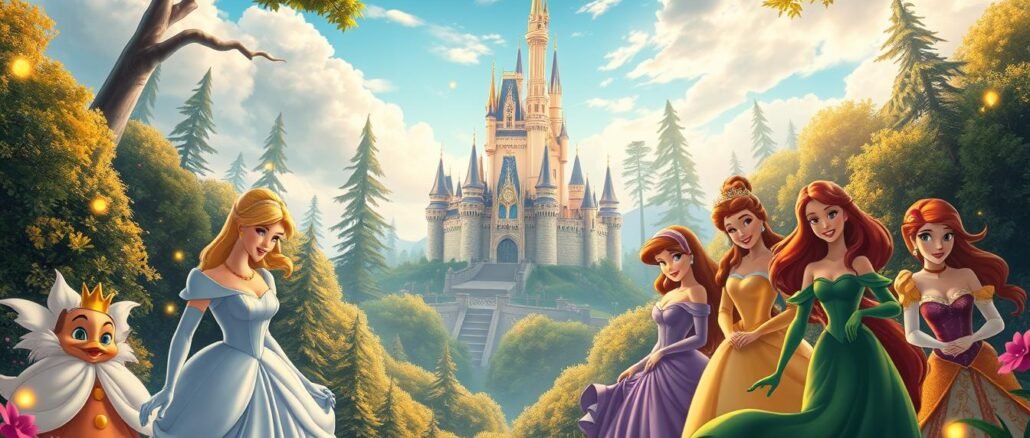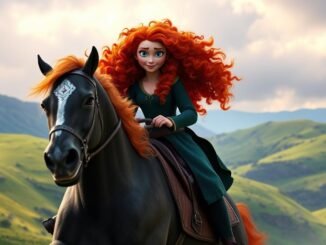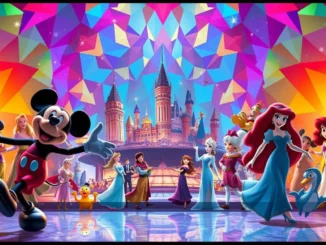
Animation has been a cornerstone of entertainment for generations, captivating audiences with timeless stories and memorable characters. The world of animation is vast, encompassing a wide range of styles and genres that have evolved over time.
The magic behind beloved animations lies in their ability to transport viewers to new worlds, evoke emotions, and create lasting connections. Through animated storytelling, creators can convey complex ideas, explore the human condition, and inspire imagination.
Key Takeaways
- The history of animation spans multiple decades, with various styles emerging over time.
- Beloved animations have a significant impact on popular culture.
- Animated storytelling allows for creative expression and emotional connection.
- The art of animation continues to evolve with technological advancements.
- Timeless classics and modern masterpieces coexist in the world of animation.
The History of Beloved Animations
The evolution of animation has been a remarkable journey, marked by significant milestones and creative breakthroughs. From its early beginnings to the sophisticated techniques used today, animation has captivated audiences worldwide with its unique blend of artistry and technology.
Early Pioneers in Animation
The history of animation began with pioneers who experimented with various techniques to bring drawings to life. One such innovator was Winsor McCay, known for his short film Gertie the Dinosaur (1914), which showcased early animation techniques. Hanna-Barbera later revolutionized television animation with beloved series that remain iconic today.
The development of animation techniques continued with the introduction of new technologies. For instance, the multiplane camera, invented by Ub Iwerks, added depth to animated scenes, enhancing the visual experience.
The Golden Age of Animation
The Golden Age of Animation, spanning from the 1920s to the 1960s, was a period of significant creative output. Studios like Disney, Warner Bros., and MGM produced some of the best animated films and iconic animated series that have become animated classics. Disney’s Snow White and the Seven Dwarfs (1937) was a landmark achievement, being the first full-length animated feature film.
“The art of animation is about creating a world that audiences can immerse themselves in, and it’s a continuous process of innovation and storytelling.”
| Studio | Notable Animated Films/Series | Year |
|---|---|---|
| Disney | Snow White and the Seven Dwarfs | 1937 |
| Warner Bros. | Looney Tunes | 1930 |
| MGM | Tom and Jerry | 1940 |
Modern Developments and Innovations
In recent decades, animation has continued to evolve with advancements in technology. Computer-generated imagery (CGI) has become a dominant force, with films like Toy Story (1995) leading the way. Modern studios now utilize sophisticated software and techniques to create complex, visually stunning animations.
- Advancements in CGI have enabled the creation of highly detailed and realistic environments.
- New rendering technologies have reduced production times, allowing for more ambitious projects.
- The rise of independent animators has led to a diverse range of styles and storytelling approaches.
The history of beloved animations is a testament to the power of creativity and innovation. As technology continues to advance, it will be exciting to see how animation evolves in the future.
Iconic Films That Shaped Animation
From timeless classics to groundbreaking computer-generated imagery, iconic films have played a crucial role in the evolution of animation. These films have not only captivated audiences but have also inspired generations of animators and filmmakers.
Timeless Classics
Timeless classics continue to enchant audiences with their enduring stories and memorable characters. Films like Snow White and the Seven Dwarfs (1937) and The Lion King (1994) have become an integral part of popular culture, with their influence still evident in modern animation.
Some of the key characteristics that make these films timeless include:
- Memorable storytelling that resonates with audiences of all ages.
- Beloved characters that have become icons in their own right.
- Innovative animation techniques that were groundbreaking at the time of their release.
| Film Title | Release Year | Notable Features |
|---|---|---|
| Snow White and the Seven Dwarfs | 1937 | First full-length animated feature film, innovative animation techniques. |
| The Lion King | 1994 | Stunning cinematography, memorable soundtrack, and engaging storyline. |
| Pinocchio | 1940 | Pioneering animation techniques, rich storytelling, and memorable characters. |
Breakthrough Computer-Generated Films
The advent of computer-generated imagery (CGI) marked a significant turning point in the history of animation. Films like Toy Story (1995) and Avatar (2009) pushed the boundaries of what was possible, introducing new technologies and techniques that have since become industry standards.
Key advancements in CGI include:
- The development of sophisticated software capable of creating complex animations.
- The ability to create highly detailed and realistic environments and characters.
- The integration of CGI with traditional animation techniques to create hybrid films.
Influence of Independent Animators
Independent animators have also played a significant role in shaping the animation industry. With the advent of digital tools and platforms, independent creators have been able to produce high-quality animations that showcase their unique perspectives and styles.
Independent animators have contributed to the diversity and richness of animated content, often experimenting with new techniques and narratives that might not be feasible within the constraints of mainstream productions.
The Art of Storytelling in Animation
At the heart of every beloved animation lies a compelling story that resonates with viewers. The art of storytelling in animation is a complex process that involves several key elements, including character development, visual style, and emotional resonance.
Character Development in Beloved Films
Character development is crucial in making animated characters memorable and relatable. Well-developed characters have distinct personalities, motivations, and backstories that drive the narrative forward. For instance, characters like Simba from The Lion King and Woody from Toy Story have become iconic due to their rich character development.
| Character | Movie | Notable Traits |
|---|---|---|
| Simba | The Lion King | Courage, Loyalty |
| Woody | Toy Story | Leadership, Jealousy |
| Elsa | Frozen | Independence, Vulnerability |
The Importance of Visual Style
The visual style of an animation significantly contributes to its storytelling. Vibrant colors, detailed textures, and imaginative settings can transport viewers to new worlds, enhancing the narrative’s emotional impact. The visual style can also reflect the tone and mood of the story, making it a crucial element in animated storytelling.
Emotional Resonance and Impact
Emotional resonance is what makes animations memorable and impactful. By creating characters and stories that audiences can relate to, animations can evoke strong emotions, from joy to sadness. This emotional connection is key to an animation’s success and its ranking in animated movie rankings.
In conclusion, the art of storytelling in animation is multifaceted, involving character development, visual style, and emotional resonance. By mastering these elements, animators can create stories that captivate audiences worldwide, leaving a lasting impact on the world of animation.
The Cultural Significance of Animation
The cultural significance of animation lies in its ability to reflect, shape, and challenge societal values and norms. Through beloved animations and iconic animated series, animators have the power to influence cultural narratives, making animation a vital part of our shared cultural heritage.
Animation’s Role in Society
Animation plays a multifaceted role in society, serving not only as a form of entertainment but also as an educational tool and a means of social commentary. Beloved animations often tackle complex issues, making them accessible to a wide audience, including children. By addressing topics such as friendship, perseverance, and overcoming adversity, these animations provide valuable lessons that resonate with viewers of all ages.
Moreover, animation has the ability to bridge cultural divides, offering insights into different cultures and ways of life. Through the portrayal of diverse characters and storylines, animated films and series can foster empathy and understanding, promoting a more inclusive society.
Diversity and Representation in Animated Works
Diversity and representation are crucial elements in the world of animation. The inclusion of diverse characters, backgrounds, and experiences in iconic animated series helps to ensure that a broad range of audiences can see themselves reflected on screen. This representation is not only important for promoting a sense of belonging among underrepresented groups but also for enriching the narrative with varied perspectives.
Furthermore, the push for greater diversity in animation has led to the creation of more nuanced and complex characters, challenging traditional stereotypes and offering fresh narratives that resonate with contemporary audiences.
Animation as a Reflection of Values
Animation serves as a mirror to society, reflecting the values, concerns, and aspirations of the time in which it is created. By examining the themes and motifs present in beloved animations, we can gain insight into the cultural context of their production. For instance, animations produced during times of social change often reflect the anxieties and hopes associated with these shifts.
The values portrayed in animation can influence audience perceptions and attitudes, making it a powerful medium for social commentary. As such, animation not only entertains but also educates and challenges its viewers, contributing to a more informed and empathetic society.
Beloved Animations Across Different Genres
The world of animation is rich and varied, with beloved animations appearing in multiple genres, from family-friendly classics to adult-oriented content. This diversity has enabled animation to cater to a broad audience, ensuring that there is something for everyone.
Timeless Family Favorites
Family-friendly classics have been a cornerstone of animation, providing entertainment that is suitable for all ages. Films like The Lion King and Toy Story have become ingrained in popular culture, offering timeless stories that continue to captivate new generations.
These beloved animations often feature memorable characters, engaging storylines, and valuable lessons, making them a staple of family entertainment.
| Film Title | Release Year | Notable Features |
|---|---|---|
| The Lion King | 1994 | Memorable soundtrack, stunning animation |
| Toy Story | 1995 | Groundbreaking computer animation, lovable characters |
| Finding Nemo | 2003 | Breathtaking underwater visuals, engaging storyline |
Exploring Fantasy and Science Fiction
Animation in the fantasy and science fiction genres has allowed creators to push the boundaries of storytelling, crafting immersive worlds that transport audiences to new and imaginative realms. Spirited Away and Wall-E are exemplary models of this, offering unique narratives that explore complex themes.
These films not only showcase the versatility of animation but also highlight its ability to tackle mature and thought-provoking subjects, appealing to a wide range of viewers.
The Emergence of Adult Animations
The rise of adult animations has marked a significant shift in the industry, with productions like Rick and Morty and BoJack Horseman gaining widespread acclaim. These shows often feature complex characters, mature themes, and satirical humor, catering to an older audience.
Adult animations have expanded the scope of what animated content can achieve, providing a platform for creators to explore more mature and nuanced storytelling.
The Future of Beloved Animations
The future of beloved animations is bright, with emerging technologies and new trends in storytelling set to captivate audiences worldwide. As we look ahead, it’s clear that Disney’s legacy in animation continues to inspire new generations.
Innovations in Animation Technology
Emerging technologies are revolutionizing the animation industry, enabling the creation of more sophisticated and engaging animated classics. These advancements are not only enhancing the visual quality of animations but also opening up new possibilities for storytelling and character development, bringing beloved animated characters to life in unprecedented ways.
Evolving Storytelling Trends
New trends in animated storytelling are focusing on diverse narratives and complex characters, reflecting the changing values and preferences of modern audiences. This shift is leading to a more inclusive and varied landscape in animation, where animated storytelling can explore different themes and genres.
The Rise of Streaming Platforms
Streaming platforms have become crucial in the distribution and discovery of animated content. With more platforms emerging, there’s a growing demand for high-quality animations. As seen with the reboots of classic shows on Max, the future of beloved animations is likely to be shaped by the intersection of technology, creativity, and changing viewer habits.
FAQ
What makes an animated film or series beloved?
A combination of factors, including engaging storytelling, memorable characters, and impactful visuals, contribute to making an animated film or series beloved. Timeless classics and modern masterpieces alike have captivated audiences with their unique blend of artistry and narrative.
How has the history of animation influenced its current state?
The history of animation, from early pioneers to modern developments, has significantly influenced its current state. Innovations in techniques, technologies, and storytelling have shaped the industry, enabling the creation of complex, engaging animated works that resonate with diverse audiences.
What role do iconic animated films play in the industry?
Iconic animated films have played a crucial role in shaping the industry, pushing the boundaries of storytelling, and inspiring future generations of animators and filmmakers. These films continue to be celebrated for their artistry, narrative, and impact on popular culture.
How does animation contribute to cultural significance and representation?
Animation contributes to cultural significance by reflecting and shaping societal norms and values. It provides a platform for diverse representation, addressing complex issues, and promoting understanding and empathy. Animated works can have a profound impact on audiences worldwide, making them an important part of our shared cultural heritage.
What can we expect from the future of animation?
The future of animation is expected to be shaped by emerging technologies, new trends in storytelling, and the growing importance of streaming platforms. These developments will continue to evolve the industry, enabling the creation of innovative, engaging animated content that captivates audiences and pushes the boundaries of the medium.
How have streaming platforms impacted the distribution of animated content?
Streaming platforms have revolutionized the distribution of animated content, providing a global audience with access to a vast library of films and series. This shift has enabled creators to reach wider audiences and has changed the way animated content is consumed and discovered.
What are some of the most popular animated genres?
Popular animated genres include family-friendly classics, fantasy, science fiction, and adult animations. Each genre offers unique storytelling opportunities, appealing to different audiences and allowing creators to explore a wide range of themes and narratives.



